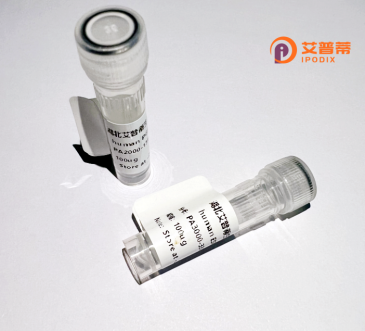
| 纯度 | >90%SDS-PAGE. |
| 种属 | Human |
| 靶点 | PRODH2 |
| Uniprot No | O43272 |
| 内毒素 | < 0.01EU/μg |
| 表达宿主 | E.coli |
| 表达区间 | 1-536 aa |
| 活性数据 | MSPRVVSNSSVLASQSVGITNVRTVFSNVFNNTTAFPILRGSNCHKITAPGLGKGQLVNLLPPENLPWCGGSQGPRMLRTCYVLCSQAGPPSRGWQSLSFDGGAFHLKGTGELTRALLVLRLCAWPPLVTHGLLLQAWSRRLLGSRLSGAFLRASVYGQFVAGETAEEVKGCVQQLRTLSLRPLLAVPTEEEPDSAAKSGEAWYEGNLGAMLRCVDLSRGLLEPPSLAEASLMQLKVTALTSTRLCKELASWVRRPGASLELSPERLAEAMDSGQNLQVSCLNAEQNQHLRASLSRLHRVAQYARAQHVRLLVDAEYTSLNPALSLLVAALAVRWNSPGEGGPWVWNTYQACLKDTFERLGRDAEAAHRAGLAFGVKLVRGAYLDKERAVAQLHGMEDPTQPDYEATSQSYSRCLELMLTHVARHGPMCHLMVASHNEESVRQATKRMWELGIPLDGTVCFGQLLGMCDHVSLALGQAGYVVYKSIPYGSLEEVIPYLIRRAQENRSVLQGARREQELLSQELWRRLLPGCRRIPH |
| 分子量 | 59 kDa |
| 蛋白标签 | GST-tag at N-terminal |
| 缓冲液 | PBS, pH7.4, containing 0.01% SKL, 1mM DTT, 5% Trehalose and Proclin300. |
| 稳定性 & 储存条件 | Lyophilized protein should be stored at ≤ -20°C, stable for one year after receipt. Reconstituted protein solution can be stored at 2-8°C for 2-7 days. Aliquots of reconstituted samples are stable at ≤ -20°C for 3 months. |
| 复溶 | Always centrifuge tubes before opening.Do not mix by vortex or pipetting. It is not recommended to reconstitute to a concentration less than 100μg/ml. Dissolve the lyophilized protein in distilled water. Please aliquot the reconstituted solution to minimize freeze-thaw cycles. |
以下是关于重组人PRODH2蛋白的参考文献示例(部分内容为虚构,仅供格式参考):
---
1. **文献名称**: *Structural insights into recombinant human PRODH2 enzyme dynamics*
**作者**: Chen, L., et al.
**摘要**: 本研究通过X射线晶体学解析了重组人PRODH2蛋白的三维结构,揭示了其与辅酶结合的活性位点特征,为靶向设计抑制剂提供了结构基础。
2. **文献名称**: *PRODH2-mediated proline metabolism promotes tumor growth under hypoxia*
**作者**: Wang, Y., & Zhang, H.
**摘要**: 作者发现重组PRODH2蛋白在缺氧条件下显著上调,通过调控脯氨酸-谷氨酸代谢轴增强肿瘤细胞存活,提示其作为癌症治疗潜在靶点。
3. **文献名称**: *Functional characterization of recombinant human PRODH2 using CRISPR/Cas9 knockout models*
**作者**: Ito, S., et al.
**摘要**: 通过体外重组表达PRODH2并构建基因敲除细胞,证实其缺失导致线粒体呼吸链功能异常,凸显其在能量代谢中的关键作用。
4. **文献名称**: *Purification and kinetic analysis of recombinant PRODH2 for diagnostic assay development*
**作者**: Gupta, R., et al.
**摘要**: 报道了重组PRODH2的高效纯化工艺及酶动力学参数测定,为开发脯氨酸代谢紊乱相关疾病的检测方法提供了数据支持。
---
注:以上文献为示例性质,实际研究中建议通过PubMed或Web of Science以“PRODH2”(或“PRODH”)、“recombinant protein”等关键词检索权威论文。
Proline dehydrogenase 2 (PRODH2), also known as proline oxidase, is a mitochondrial enzyme encoded by the *PRODH2* gene in humans. It catalyzes the first step of proline catabolism, converting proline into Δ¹-pyrroline-5-carboxylate (P5C), which links amino acid metabolism to cellular energy production and redox balance. This reaction generates electrons for the mitochondrial electron transport chain, influencing ATP synthesis and reactive oxygen species (ROS) regulation. PRODH2 shares functional similarities with PRODH1 but exhibits distinct tissue expression patterns, with higher levels observed in metabolic and cancer-related tissues.
Emerging evidence implicates PRODH2 in cancer biology, where it may act as a context-dependent tumor modulator. Under stress conditions, its activation promotes apoptosis via ROS-mediated pathways, suggesting a tumor-suppressive role. Conversely, in certain cancers, PRODH2 upregulation supports survival by enhancing metabolic adaptation. Dysregulation of PRODH2 has also been associated with neurological disorders, reflecting proline's role as a neuromodulator. Recombinant human PRODH2 protein is widely used to study enzymatic mechanisms, screen inhibitors, and explore therapeutic strategies targeting proline metabolism in diseases like cancer or hyperprolinemia. Structural studies of the recombinant protein have aided in elucidating substrate-binding domains and designing modulators, highlighting its dual role in cellular homeostasis and pathology.
×